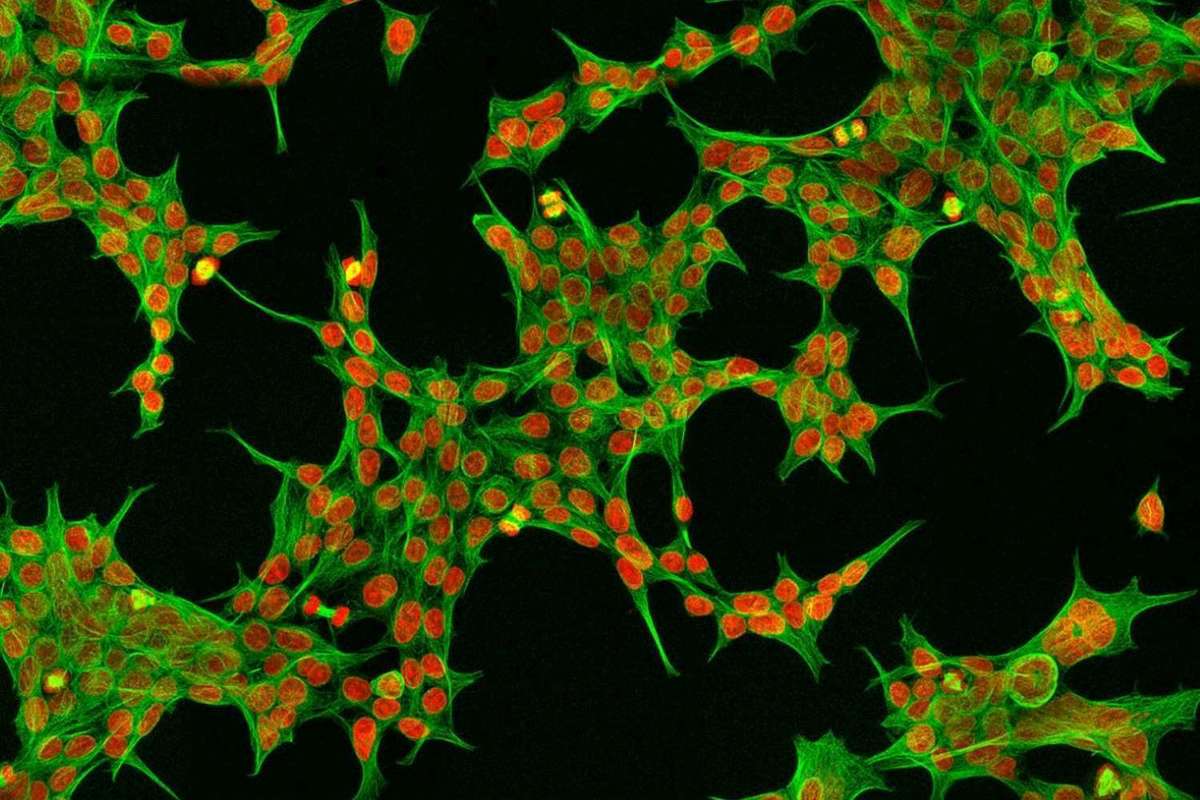We have learned, in the last few months, a lot about the cell line HEK293, derived from the remains of an unborn child in the Netherlands in 1973. Not only is it the most common cell line used in vaccine production and testing (even the synthetic mRNA vaccines made by Moderna and Pfizer had recourse to it in testing), but it is, apparently, ubiquitous in modern life. Our homes are chock full of products at least tested on HEK293, from drugs (almost all of them, in fact) to processed food to cosmetics. Avoiding every product with any connection whatsoever to HEK293 is virtually impossible.
We have also learned that this cell line, which has long been assumed to have been derived from the tissue of an aborted child may, in fact, have been derived from the tissue of a miscarried, or “spontaneously aborted,” child. Why did we long believe the cell line to be abortion derived? The simple answer is that Frank Graham, the scientist who first derived the cell line, had always simply assumed that the tissue on which he worked had been derived from an elective abortion.
He was not involved in the abortion, nor the procurement of the tissue. But he judged that the fetus was in good health at the time of its death, which makes abortion more likely than miscarriage, and he worked in a context where using the human remains of aborted children was not uncommon. Given that abortions are much easier to predict and control than miscarriages, one could expect that, absent any moral qualms, those responsible would more regularly procure human remains from elective abortions than from miscarriages. All things considered, his assumption was quite reasonable.
But it remains just that: an assumption. When priest-scientist Nicanor Pier Giorgio Austriaco, O.P. e-mailed Professor Graham to gain clarity on the matter, he learned that Graham did not, and could not, know for certain. At this remove, 50 years later, it seems highly likely that we will never know for sure the precise provenance of HEK293 with respect to abortion. What are we to make of this?
One response is to claim that this newfound doubt is a kind of just-so story crafted from the feeblest evidence and likely to lull people into moral laziness so that they do not take the issue of cell lines derived from aborted children with the seriousness the question requires. We believed for years that HEK293 was derived from abortion and even now that seems to be the most likely scenario. Casting this doubt only muddies the waters.
A second response is to simply assume that the child was aborted and do the appropriate moral analysis on that assumption, perhaps with a slight caveat. This has been the response of most ethicists, and seems partly designed to alleviate the concerns mentioned in the first response. Indeed, even if the child was aborted, the virtually unanimous community of faithful Catholic ethicists, the vast majority of bishops, and the Magisterium of the Church all agree that, according to established Catholic moral principles, reception of these vaccines is easily justified in the present case. So, it would seem, the doubt cast here really makes very little difference. The moral conclusion regarding vaccination stands, unaffected.
Still, I suspect many of us are not completely satisfied at this stage. Surely this possibility means something. But what? Can reflecting on this problem help clarify our moral thinking around HEK293? Let’s see if a thought experiment might shed some light.
A Thought Experiment
Imagine a firing squad in which half of the rifles contain live ammunition and half contain blanks. The shooters do not know which their rifle contains. It is true, in a very real sense, that only those with live ammunition actually kill the condemned person. But are we satisfied to assert any marked moral difference between those who unwittingly shot bullets and those who unwittingly shot blanks? From a subjective point of view, of course, it is perfectly natural to wish that one’s own rifle held the blanks. But should that possibility give us any sense of moral superiority over our neighbor whose rifle contained live ammo?
Similarly, let us imagine a group of scientists working in a lab, trying to develop cell lines from human fetal remains. And let us say that the scientists have available to them ten cadavers, some of which were aborted and some of which were miscarried. The scientists have no means of knowing which is which or even how many of each there are. They only know that the folks acquiring the human remains for the lab are not picky on this point. They work away diligently and eventually succeed in producing a cell line which is of immense practical value to medical research. Of course, it is perfectly natural to wish that the cell line was derived from the tissue of a child that was miscarried and not aborted. But does something so contingent change our ethical evaluation of the situation? Do we think that, if the cell line just happened to come from a miscarried child, it is justified, but if it happened to come from an aborted child, it is not?
A Corrupt System
Thinking about these questions should help us to see more clearly some key issues related to the bigger question of research on fetal tissue. For instance, if we hope that the cell line was derived from a miscarried, and not an aborted, child, we are implicitly recognizing that there is nothing inherently wrong with research on human remains, including fetal human remains. Further, we should notice that it is not the case that research on aborted children becomes evil simply because these children were murdered. If I consent to organ donation, or donate my body to science, my being murdered is a grave injustice, but it does not render immoral transplanting my organs or using my remains for research. Why, then, is research on the remains of aborted children wrong?
First, because respect for the dignity of human remains demands that they be used for research or organ donation only with proper consent. A murdered adult can give their own prior consent. And a miscarried child’s parents can justly consent on the child’s behalf. But in the case of the aborted child, no one who cooperated in the abortion, including the mother, has the moral standing to donate the body of the abortion’s victim.[1]
On its own, this would seem to make research on the remains of aborted children the moral equivalent of research on the remains of miscarried children whose parents did not, for whatever reason, give their consent. Many will find this conclusion unsatisfying. Does the abortion really make no difference at all? But there is a further consideration. Catholic moral theology considers that, in addition to the morality of the act itself and the intention with which the act is committed (both of which must be neutral or good for an act to be good), circumstances may mitigate or amplify the good or evil done and/or our culpability for such good or evil.[2]
Circumstances cannot make evil good, but they can lessen or strengthen our moral condemnation. For instance, things like ignorance, addiction, or duress commonly lead to more qualified moral judgments, sometimes even removing culpability altogether. In the present case, on the other hand, the circumstances do not mitigate the evil, but augment it. Consider: if an adult murder victim’s remains were used for organ donation or scientific research when they had not consented to such actions, that would be a serious injustice. The same goes for unborn children. But if there were a whole medical complex that regularly, even systematically, killed adults for various reasons unrelated to scientific research, but then entered into relationships with research institutes and practitioners to donate the bodies of the victims, that would be utterly horrifying.[3]
All of which is to say that what makes the research done on aborted children particularly egregious is not the fact of their having been murdered—which, however unjust, is no impediment at all to ethical research in itself—nor the fact that proper consent is lacking—which is surely unjust, but does not seem enough to fully account for the depth of depravity on display—but that such children represent a systematically dehumanized population whose dehumanization is furthered by the fact of their being so casually exploited in such research. What’s more, such a system is not only unjust to unborn children, but corrupts the character and conscience of innumerable medical and scientific professionals, and even of the general public. The question, then, is helpfully reframed not as being about the morality of this or that cell line which may or may not have been derived from the remains of an aborted child, but about a system so immoral, even amoral, that it does not care one way or another.
Physicalism
Which brings us to another point on which we might gain some clarity. Surely, upon reflection, we are unsatisfied by the idea that a cell line is ethical if it just happened to have been developed from the remains of one of the miscarried children in our imagined lab and only unethical if it was developed from the remains of one of the aborted children. But why are we tempted to think that way in the first place? I suspect that a significant part of the problem here is our tendency to imagine artifacts themselves as ethical or unethical. But artifacts are never evil in themselves. They can only be spoken of as evil by analogy to the evil for which they may be intended.
Acts can be evil. Intentions can also rightly be called evil. But artifacts can be used for good or ill. Catholic teaching may be opposed to artificial contraception, but no one really thinks that a Catholic soldier cannot use the condom in his survival kit as a makeshift canteen to enable him to carry more water when setting out from a desert oasis. Moreover, products of evil actions do not thereby become evil themselves. A child conceived in rape might be the most poignant example. But it is also true of products made with exploited or even slave labour. T-shirts and railways are not evil.
So, cell lines, no matter how derived, are not ethical or unethical. They may have been created unethically and they may even be used unethically, but those are separate questions about actions and intentions. In the case of our thought experiment, do we have any grounds for suggesting that a cell line derived, by chance, from a miscarried child’s remains was produced ethically and that a cell line derived, by chance, from an aborted child’s remains was produced unethically? I cannot see that we do.
What we can say, rather, is that the abortions were gravely unjust. Furthermore, we can say that the use of the fetal remains of the aborted children for research was also unjust. Those judgements stand no matter whose tissues produced the successful cell line. Finally, the cell line itself, being an artifact that cannot be good or evil in any case, does not become good or evil depending on whose tissues were used to produce it.
Conclusion
Morality is rooted in actions and intentions, not physical artifacts. And so any morally relevant connection with the evil of abortion must be traced, not through cell lines, but through the series of actions and intentions these cell lines represent. It is important to recognize that any potentially related abortions were done for reasons unrelated to scientific research. It was gravely unjust, but there was no intention to kill children for science. On the other hand, the decision to use the fetal remains of children who were aborted—not only without consent, but when proper consent was hardly possible—is condemnable. HEK293 was derived under these circumstances whether or not the line itself came from an aborted or miscarried child.
If this is the case—since traditional Catholic moral principles make it clear that the reception of vaccines produced with or tested on HEK293 is easily justified in a global pandemic (how could it not be if taking a Tylenol, also tested on HEK293, is justified by a headache?)—then perhaps the time has come for us to focus our moral concern on the ongoing use of the remains of aborted children in research? Given both the immense therapeutic promise of stem cell research and the moral impermissibility of acquiring embryonic stem cells from aborted children, the Catholic Church has put its money where its mouth is in funding medical research with adult stem cells.
Can we not use our collective moral energy and human and financial resources to think about how we might do something analogous with cell lines and other areas of medical research that continue to make use of aborted children? We cannot alter the past; sometimes we cannot even know it. But we can build a more just future.
[1] Theoretically, perhaps, a father or grandparent who did not approve of the abortion may have such moral standing, but it strains credulity to imagine such consent was ever sought or given. In fact, we know that consent was not sought for these matters in the Dutch medical system at the time, whether in cases of abortion or miscarriage. Human remains were, in either case, essentially treated as medical waste.
[2] For background in this rather technical aspect of Catholic teaching, see the section “The Sources of Morality” in the Catechism of the Catholic Church, starting at paragraph 1749.
[3] The fact that it would be perhaps more horrifying if the adults were killed specifically for scientific research does not significantly affect our judgment here. Nor does that fact that abortion was, technically, illegal in the Netherlands at the time, with exceptions in place to save the life of the mother. The situation described obtains in any case.


